Discover 20 hidden attractions, cool sights, and unusual things to do in Lynchburg (United States). Don't miss out on these must-see attractions: Anne Spencer House, Lynchburg Museum, and Bank of the James Stadium. Also, be sure to include Old City Cemetery in your itinerary.
Below, you can find the list of the most amazing places you should visit in Lynchburg (Virginia).
Table of Contents
Anne Spencer House
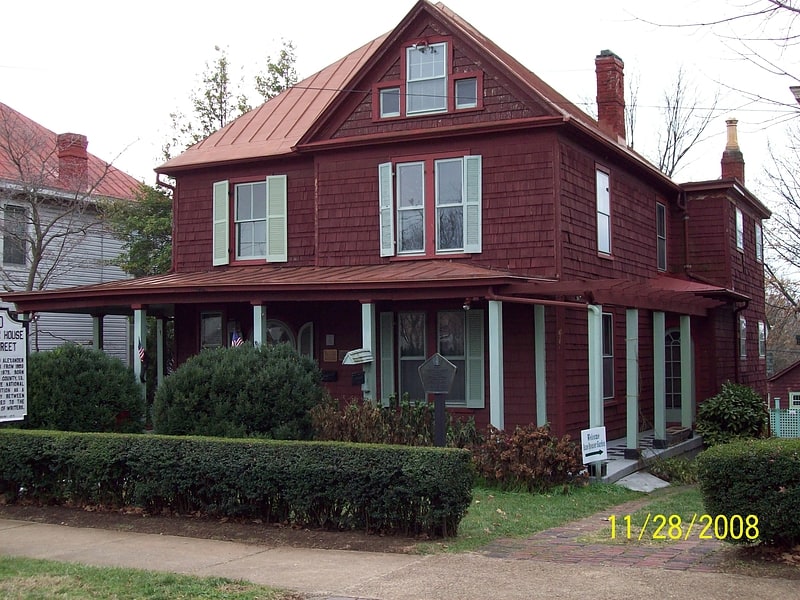
Museum in Lynchburg, Virginia. The Anne Spencer House, in Lynchburg, Virginia, United States was, from 1903 to 1975, the home of Anne Spencer, a poet of the Harlem Renaissance.[1]
Address: 1313 Pierce St, 24501-1935 Lynchburg
Lynchburg Museum
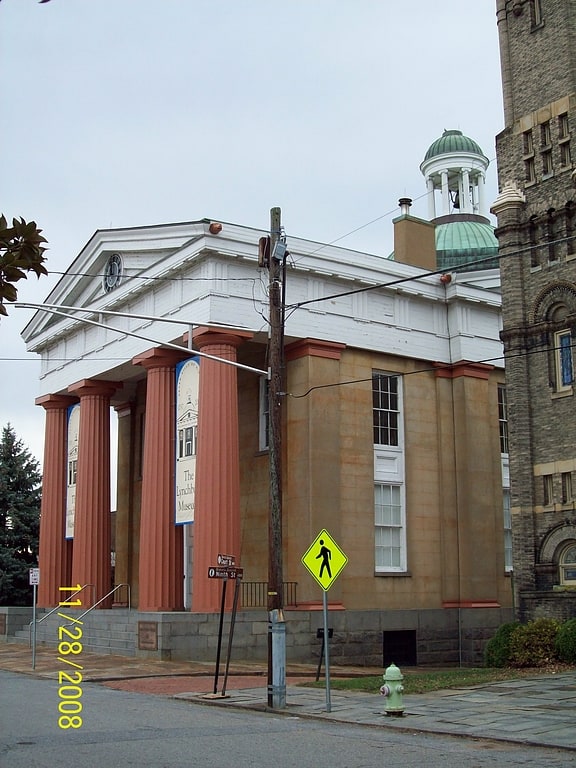
Courthouse. The Lynchburg Courthouse is a historic courthouse building located at Lynchburg, Virginia. Built in 1855, it occupies a prominent position overlooking the steeply descending steps of Monument Terrace. The building is executed in stucco-over-brick on a granite ashlar basement and is an example of the Greek Revival. The building is capped by a shallow dome located over the intersection of the ridges. At the top of the dome is a small open belfry consisting of a circle of small Ionic columns supporting a hemispherical dome. The front of the court house has a three-bay Doric portico.
It was listed on the National Register of Historic Places in 1972. It is located in the Court House Hill-Downtown Historic District.[2]
Address: 901 Court St, 24504-1603 Lynchburg
Bank of the James Stadium

Stadium in Lynchburg, Virginia. Bank of the James Stadium, located in Lynchburg, Virginia, was originally constructed in 1939 to be used as a complex for professional baseball teams. The baseball stadium was built in conjunction with an adjacent 6,000-person football stadium. The New York Yankees and the Brooklyn Dodgers played in the inaugural game at City Stadium on April 11, 1940 in front of an estimated crowd of 7,000. The following professional baseball teams have all fielded affiliates of their parent club in Lynchburg: the Washington Senators, St. Louis Cardinals, Chicago White Sox, Minnesota Twins, Texas Rangers, New York Mets, Boston Red Sox, Pittsburgh Pirates, Cincinnati Reds, and Atlanta Braves. The stadium is currently home to the Lynchburg Hillcats of the Low-A East, and is one of the oldest active ballparks in Minor League Baseball. The Hillcats have been an affiliate of the Cleveland Indians since 2015. From 2010–2014 they were affiliated with the Atlanta Braves. In 2005, the Hillcats set an attendance record with a total of 151,266 fans passing through the gates.[3]
Address: 3176 Fort Ave, 24501-3810 Lynchburg
Old City Cemetery
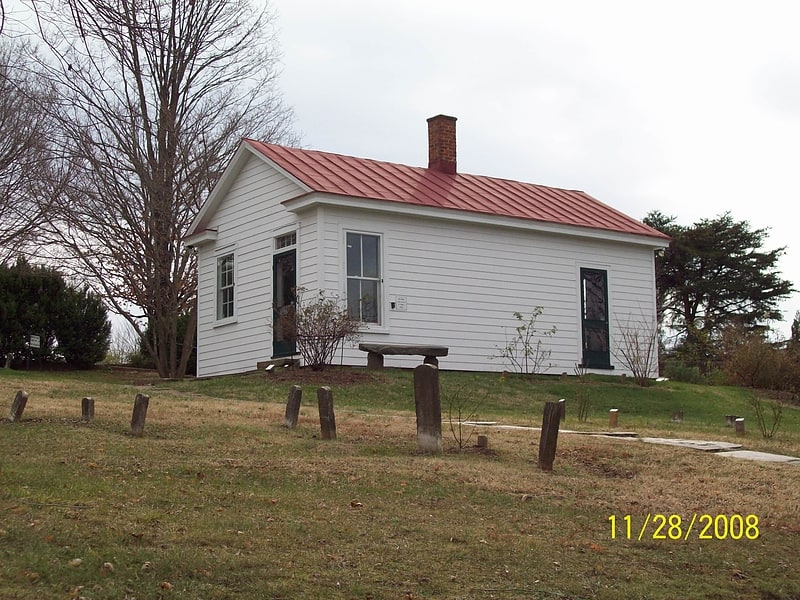
Cemetery in Lynchburg, Virginia. The Old City Cemetery is a historic cemetery in Lynchburg, Virginia. It is the oldest municipal cemetery still in use today in the state of Virginia, and one of the oldest such burial grounds in the United States. Since the 1990s it has been operated as a history park and arboretum, in addition to being an active cemetery.
The exact number of interments in Old City Cemetery is unknown because of a lack of official records before 1914, but it is estimated that 18,000–20,000 people are at final rest there. They represent an unusually diverse cross-section of the local community, including founding fathers and mothers of the town, Confederate soldiers who died in military hospitals, African American tobacco factory laborers, European immigrants, paupers, and "strangers" who died passing through town.
Two-thirds of the burials in the cemetery are African American. It has been estimated that over 90% of Lynchburg's enslaved and free African American population are buried in the Old City Cemetery, the primary burial site for African Americans from 1806 to 1865. In fact, at that time it was the only burial ground, excluding private family graveyards, available to African Americans in the area. A notable burial is that of Ota Benga (c. 1883–1916), a Congolese pygmy exhibited at human zoos, although his remains may have been later moved to Lynchburg's White Rock Hill Cemetery.
The cemetery's Confederate section contains the graves of over 2,200 soldiers from 14 states. Also interred at the cemetery is poet Bransford Vawter.
The cemetery was established on land donated to the City of Lynchburg by city founder John Lynch. The original deed for the property states it shall be used as a public burying ground or for a house of worship—and for no other purpose whatsoever.
The 27-acre (11 ha) site includes four small historic house museums located inside the cemetery, which is cared for by the Southern Memorial Association.
- Pest House Medical Museum, Lynchburg's first hospital
- Hearse House and Caretakers' Museum, museum about the cemetery and funerals
- Station House Museum, a reconstructed C&O Railway depot furnished as in World War I
- Mourning Museum, museum about mourning customs, located inside the Cemetery Center
The cemetery also includes a non-denominational Chapel, built to commemorate the 200-year anniversary of the founding of Lynchburg's Old City Cemetery in 1806, and a Columbarium with niches and crypts for new burials below the Chapel.[4]
Address: 401 Taylor St, 24501-1245 Lynchburg
First Baptist Church

Baptist church in Lynchburg, Virginia. First Baptist Church is a historic Baptist church located at 1100 Court Street, Lynchburg, Virginia. It is built of hard-pressed red brick on a rough granite foundation. The main facade of the church, facing Eleventh Street, and the two sides are centered with large rose windows framed within Gothic arches covered with hood moldings. Construction began in 1884 and the church was dedicated in 1886. In the 1920s, Lynchburg architect Stanhope S. Johnson designed the complementary Sunday School annex. In 1941, the interior of the sanctuary was modified by Stanhope S. Johnson, with the creation of a divided chancel. It is home to the oldest Baptist congregation of Lynchburg, established in July 1815. Current as of 2020, First Baptist Church is affiliated with the Cooperative Baptist Fellowship.
It was listed on the National Register of Historic Places in 1982. It is located in the Court House Hill-Downtown Historic District.[5]
Address: 1100 Court St, 24504-4504 Lynchburg
Thomas Road Baptist Church
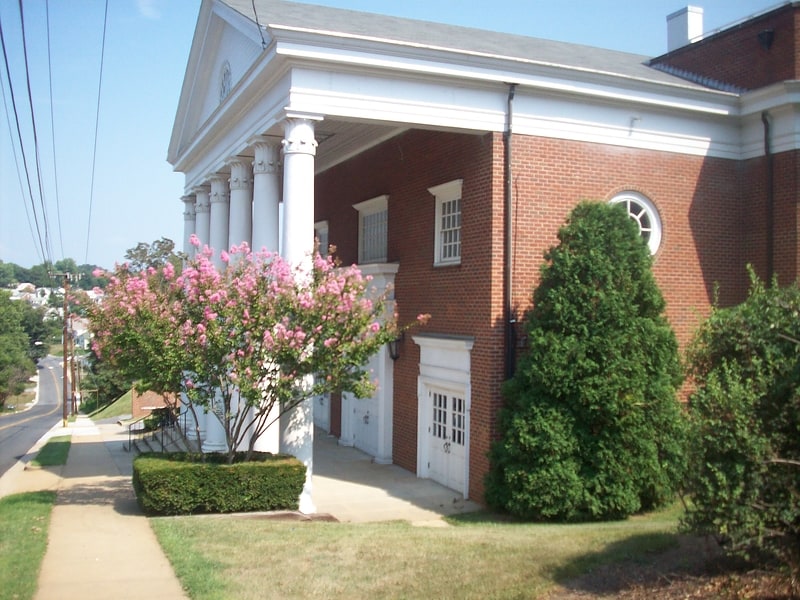
Megachurch in Lynchburg, Virginia. Thomas Road Baptist Church is a Baptist megachurch in Lynchburg, Virginia, located on the campus of Liberty University, which it founded and is closely affiliated with. In 2016, a church spokesperson stated they had an average weekly attendance of 9,000. The pastor is Jonathan Falwell, the son of previous Senior Pastor Jerry Falwell and brother of former Liberty University President, Jerry Falwell Jr. In addition to a second campus, Dan River Church, Thomas Road also hosts a Spanish congregation on its main campus. It is affiliated with the Baptist Bible Fellowship International and the Southern Baptist Convention.[6]
Address: 1 Mountain View Rd, 24514 Lynchburg
Academy of Music
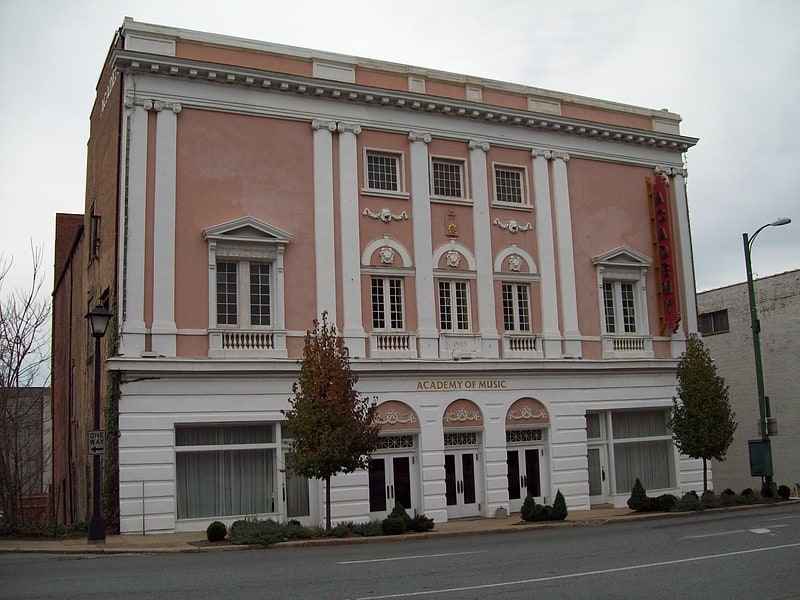
Building. The Academy of Music is a historic theatre building located in Lynchburg, Virginia. The three story theater was built 1904–05 in the Beaux Arts style with a Neoclassical interior. It was designed by Frye & Chesterman. It is one of the only surviving legitimate theaters of the turn-of-the-century period in Virginia. Some of the more notable European and American names to appear on its stage included Ignace Paderewski, Anna Pavlova, Sarah Bernhardt, Alma Gluck, DeWolf Hopper, Otis Skinner, John Drew and Mrs. Patrick Campbell. In 2008, the Lynchburg Academy of Fine Arts received a $245,000 earmark from Representative Bob Goodlatte from the Community Development Fund of the United States Department of Housing and Urban Development, for renovations to the building.
It was listed on the National Register of Historic Places in 1969.[7]
Address: 600 Main St, 24504-1322 Lynchburg
Point of Honor
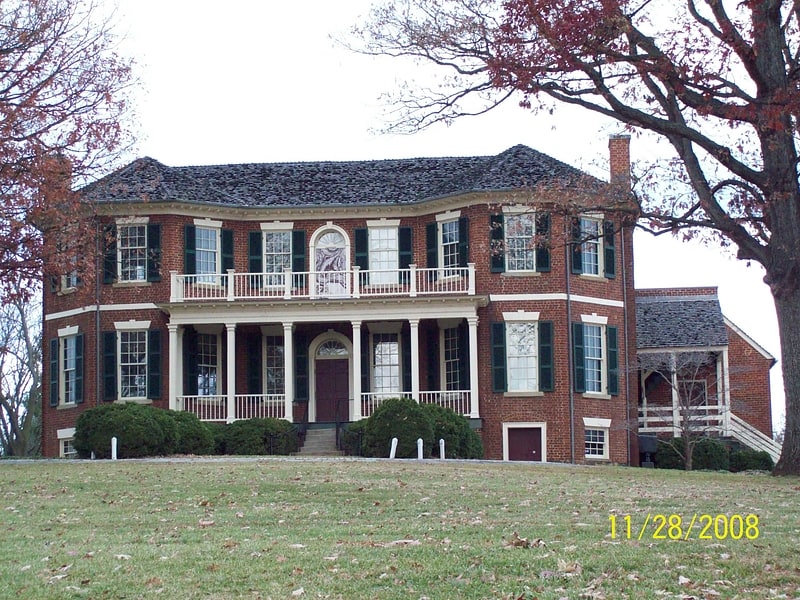
Museum in Lynchburg, Virginia. Point of Honor is an historic home, now a city museum, located in Lynchburg, Virginia. The property has commanding views of the city and the James River. Its name originated due to the land on which it is built being used as a clandestine dueling ground.[8]
Address: 112 Cabell St, 24504-1211 Lynchburg
Sandusky House

Historic Sandusky is a historic home located in Lynchburg, Virginia. It is a formal two-story, brick "I" house built about 1808, with a later addition. It was built by Charles Johnston, and is one of the earliest homes in the Lynchburg area to display the architectural details and refinements characteristic of Federal design.
While Charles Johnston lived in the house he was visited by Thomas Jefferson of Poplar Forest who went to the home as a dinner guest December 1817. Jefferson and Johnston knew each other as neighbors and traded goods often.
The home was then sold to John Mathews Otey, whose family occupied the house from 1821 to 1841, before it changed hands to George C. Hutter, whose family owned the house for over 110 years.
In 1864, during the Battle of Lynchburg, Sandusky served as Union headquarters. Among those quartered at the home were Gen. David Hunter and future Presidents Rutherford B. Hayes and William McKinley, who served on Hunter's staff. During the occupation by the Union soldiers, the residents of the house, including retired Major Hutter and his family, were locked upstairs. Before retreating, General Hunter gave orders to his troops to ransack the house, and "Union soldiers plunged bayoneted rifles into the family portraits hanging on the walls..."
Other buildings on the property consist of two 20th-century tenant houses, one frame and one brick. It is currently owned and operated by the Historic Sandusky Foundation in partnership with the University of Lynchburg as a house museum related to the American Civil War and the Battle of Lynchburg.
It was listed on the National Register of Historic Places in 1982. It was also listed on the Virginia Landmarks Register in the same year.[9]
Address: 757 Sandusky Dr, 24502-1429 Lynchburg
St. Paul's Church
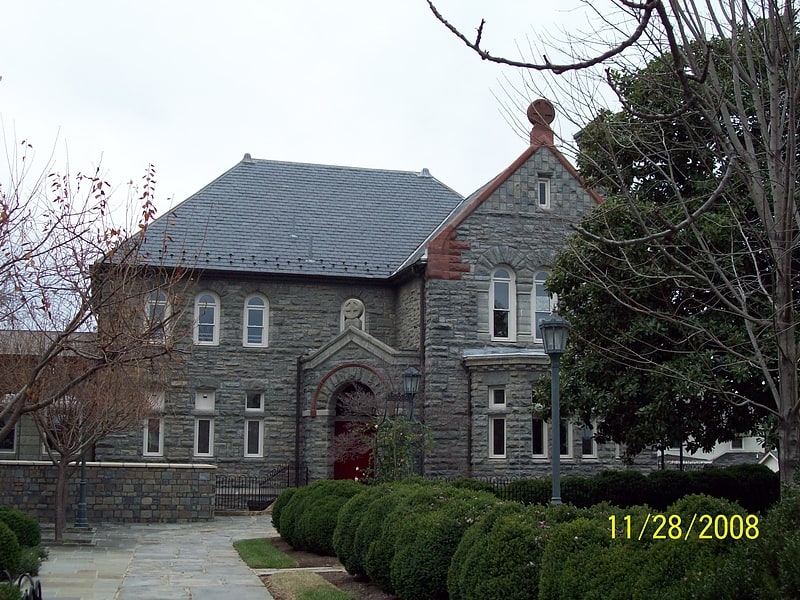
Episcopal church in Lynchburg, Virginia. St. Paul's Church is a historic Episcopal church in Lynchburg, Virginia, United States.[10]
Address: 605 Clay St, 24504-2460 Lynchburg
Amazement Square
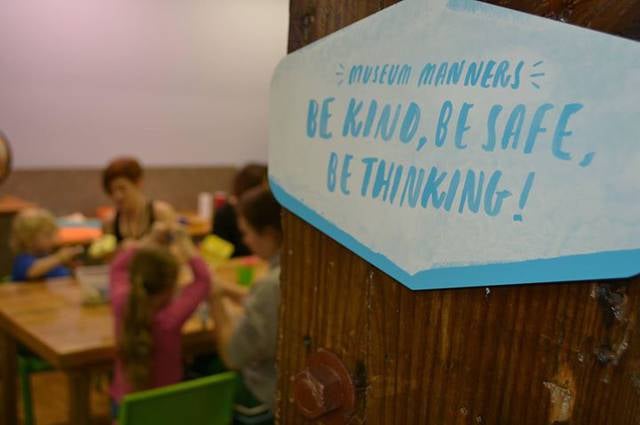
Museum, Children's museum, Science museum
Address: 27 9th St, 24504-1422 Lynchburg
Lynchburg College

Private university in Lynchburg, Virginia. The University of Lynchburg, formerly Lynchburg College, is a private university associated with the Christian Church and located in Lynchburg, Virginia, United States. It has approximately 2,800 undergraduate and graduate students. The University of Lynchburg spans 264 acres.[11]
Address: 1501 Lakeside Dr, Lynchburg
Sweet Briar College
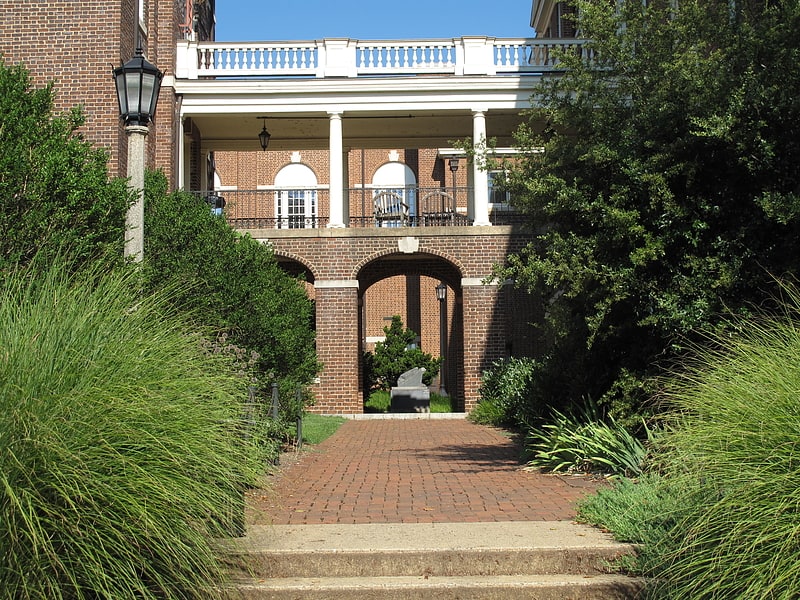
Private school in Sweet Briar, Virginia. Sweet Briar College is a private women's college in Sweet Briar, Virginia. It was established in 1901 by Indiana Fletcher Williams in memory of her deceased daughter, Daisy. The college formally opened its doors in 1906 and granted the B.A. degree for the first time in 1910. It nearly closed in 2015 but was saved by donations and legal actions by alumnae.
Sweet Briar is known for its campus with its historic Georgian Revival architecture by Ralph Adams Cram and its 3,250 acres (13.2 km2) of hills, forests, and fields.
An early leader in international study, the college established its Junior Year in France program in 1948 and is affiliated with additional study abroad programs. Its chapter of Phi Beta Kappa, the Theta of Virginia, was authorized in 1950. In 2005, it established its program in engineering, one of only two ABET-accredited engineering programs at a women’s college. The college is accredited by the Southern Association of Colleges and Schools Commission on Colleges to award the Bachelor of Arts, Bachelor of Fine Arts, Bachelor of Science and a Master of Arts in Teaching.[12]
Address: 134 Chapel Road Sweet Briar, VA 24595, Lynchburg
Fort Early and Jubal Early Monument
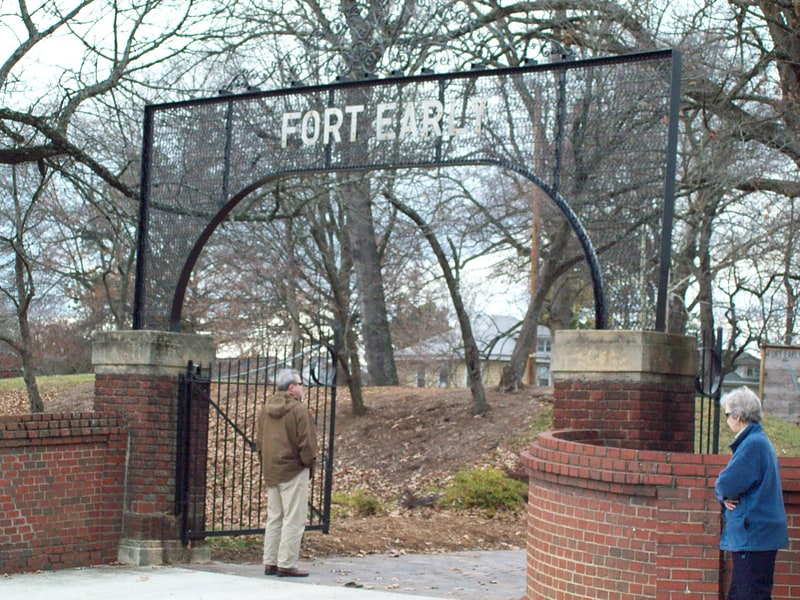
Historical landmark in Lynchburg, Virginia. The Fort Early and Jubal Early Monument was started in the early 1900s, and consists of the remains of an American Civil War fort and monument located on a 1.29-acre site at Lynchburg, Virginia. Confederate forces under the command of Lt. Gen. Jubal Early constructed the roughly square earthen fort in June 1864 as part of the outer defenses of Lynchburg as the Union Army of West Virginia, under Maj. Gen. David Hunter, advanced from the north and west in an attempt to capture the city during the Battle of Lynchburg. It is the only section of the Lynchburg defenses still in existence.
The walls of the fort are approximately 12 to 15 feet (4.6 m) in height on the exterior and approximately 4 to 6 feet (1.8 m) high on the interior. Within the fort is a one-story brick structure that was built in 1922 by the Fort Hill Woman's Club and contains exhibits on the Battle of Lynchburg. A brick paved entrance drive with a 15-foot (4.6 m) high iron arch erected in 1924, with the words "Fort Early", cut through the eastern portion of the breastworks and forms the entrance to the site. The remaining portions of the breastworks are intact including a sally port in the northern wall used to bring in ammunition and other supplies during the military operation of the fort. A 17-foot (5.2 m) high granite obelisk honoring Confederate General Jubal A. Early and erected in 1919, is located on a triangle of land formed by the intersection of Fort Avenue and Memorial Avenue.
It was listed on the National Register of Historic Places in 2002.[13]
Court Street Baptist Church

Baptist church in Lynchburg, Virginia. The tallest object on the downtown skyline of Lynchburg, Virginia, Court Street Baptist Church stands as a testament to the black Baptist population of Lynchburg. Organized in 1843, the congregation—originally known as the African Baptist Church of Lynchburg—was the first of its kind in the city. The church was designed by R.C. Burkholder, and completed in 1880.[14]
Address: 517 Court St, 24504 Lynchburg
Diamond Hill Baptist Church

Baptist church in Lynchburg, Virginia. Diamond Hill Baptist Church is a historic African-American Baptist church located at Lynchburg, Virginia. It was built in 1886, and is a three-story, "L"-shaped, brick church building in the Late Gothic Revival style. It has brick buttresses capped with limestone, Gothic pointed arched windows, a three-story entrance tower with steeple, and a jerkinhead roof. From 1958 to 1963 the pastor was Virgil Wood, the pastor most associated with the Civil Rights Movement in Lynchburg.
Individually listed on the National Register of Historic Places in 2011, it is located in the Diamond Hill Historic District.[15]
Address: 1415 Grace St, Lynchburg
Thomas Jefferson's Poplar Forest

Restored home and land of former president. Poplar Forest is a plantation and plantation house in Forest, Bedford County, Virginia. Thomas Jefferson designed the plantation and used the property as a private retreat and a revenue-generating plantation. Jefferson inherited the property in 1773 and began designing and working on the plantation in 1806. While Jefferson is the most famous individual associated with the property, it had several owners before being purchased for restoration, preservation, and exhibition in 1984.
Poplar Forest was designated as a National Historic Landmark in 1971 and is presently operated as a historic house museum by the nonprofit Corporation for Jefferson’s Poplar Forest. The Corporation is also responsible for the ongoing archaeological study and restoration work at the property.[16]
Address: 1542 Bateman Bridge Rd, 24551-4239 Forest
Allied Arts Building

High-rise building. The Allied Arts Building is a historic high-rise building located at 725 Church Street in Lynchburg, Virginia. It is currently being remodeled for apartments.
Construction of the building began in 1929 and was completed in 1931, and it was designed by Stanhope S. Johnson and Addison Staples. The 17-story, 40-foot (12 m) by 132-foot (40 m) building is steel framed and faced in yellow brick and greenstone in Art Deco style. Its outer shape and design is very similar to that of the Central National Bank in Richmond, Virginia.
It was listed on the National Register of Historic Places in 1985. It is located in the Court House Hill-Downtown Historic District.[17]
Address: 725 Church Street, Lynchburg
Bragassa Toy Store

Building in Lynchburg, Virginia. The Bragassa Toy Store is a historic commercial building located in Lynchburg, Virginia. In 1871, Francisco Bragassa purchased the property and in 1875 to 1876, he built the confectionery and toy store in Italianate style. The Bragassa store was at the center of a new, expanding commercial section of town during the Reconstruction period. It is the only surviving building within a four-block area that represents this commercial expansion. The building contains comfortable living quarters upstairs, with the merchandise on the ground floor. At the front of the shop were the first plate glass windows ever installed in Lynchburg. The store remained in the Bragassa family until 1987. In January 1988 the Lynchburg Historical Foundation purchased the building from the Bragassa family. In November 2008, the building was occupied by Kid's Haven: A Center for Grieving Children.
It was listed on the National Register of Historic Places in 1991.[18]
Aviary
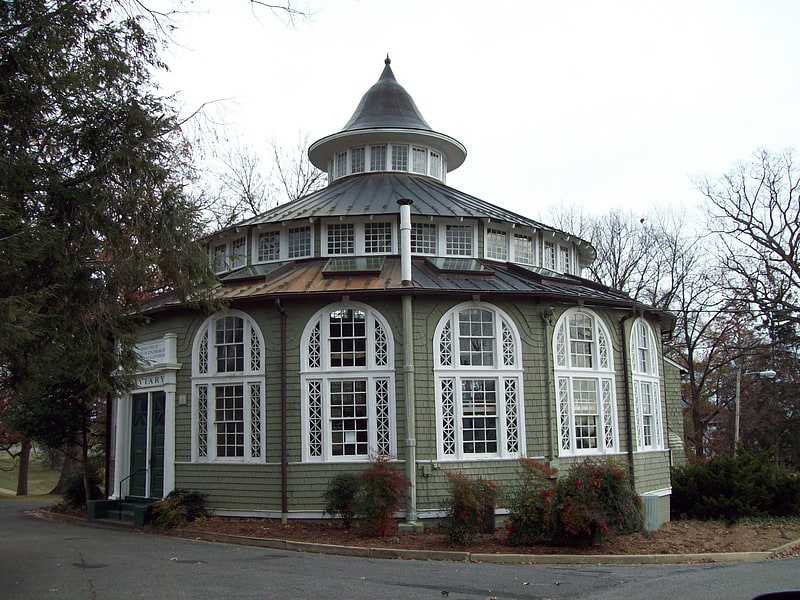
Building in Lynchburg, Virginia. The Aviary is a historic aviary building located in Miller Park at Lynchburg, Virginia. It is a Queen Anne-style structure erected in 1902. The multi-sided exhibition house was designed by the local architectural firm of Frye & Chesterman. The building was a gift to the city of Lynchburg from Randolph Guggenheimer of New York City. When completed, the Aviary housed, "Seven cages containing monkeys, one with at least a half dozen healthy alligators, one with cockatoos, one with Australian doves, one with parrots and one with canaries." It later became a branch library and an office structure for the city Department of Parks and Recreation.
It was listed on the National Register of Historic Places in 1980.[19]
Address: 402 Grove Street, 24501 Lynchburg